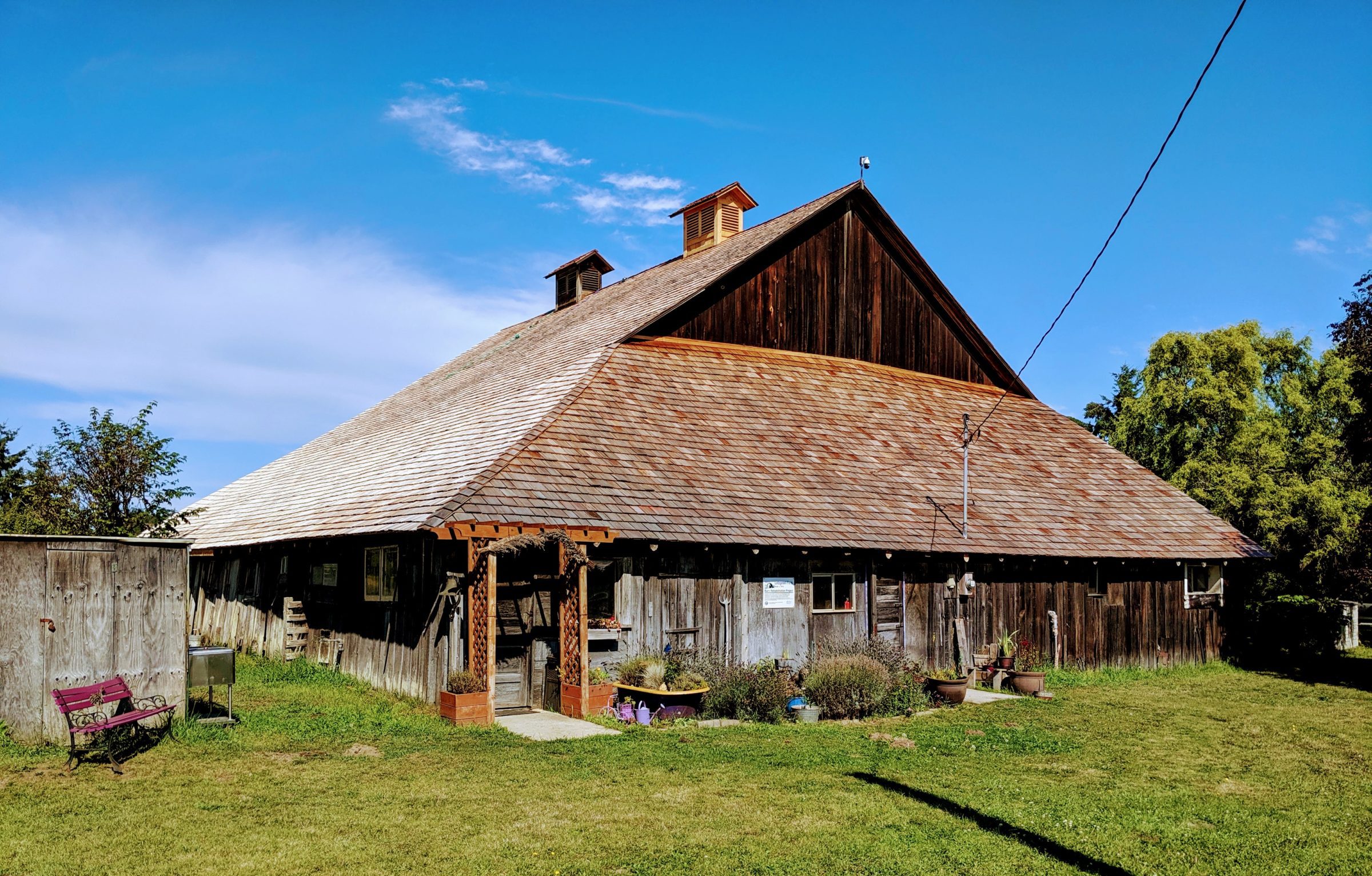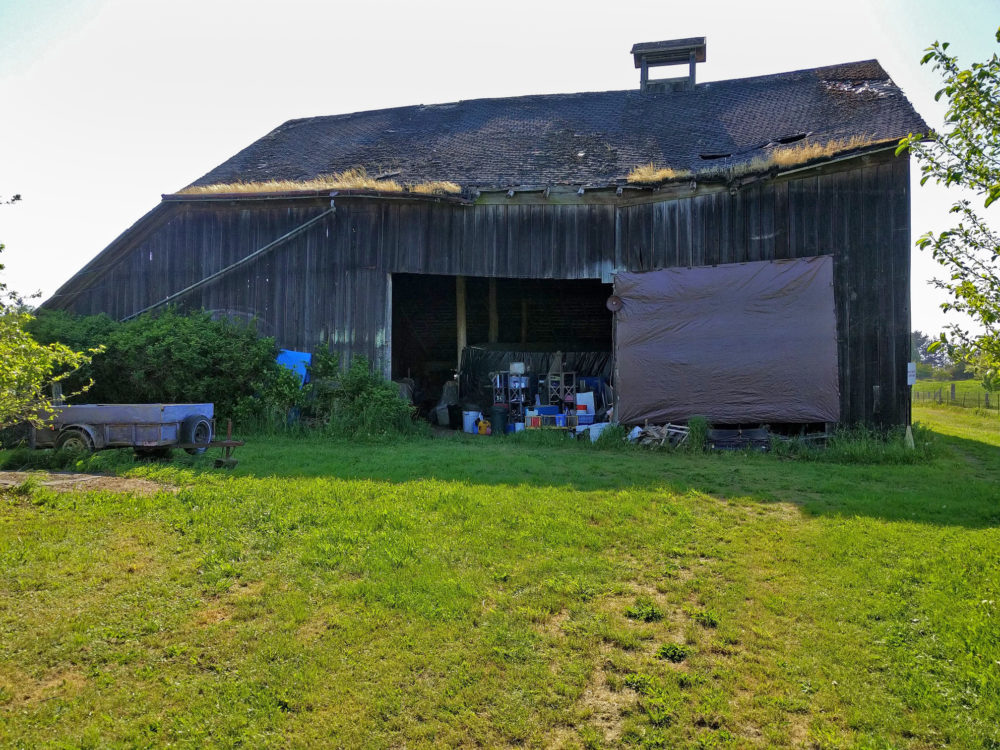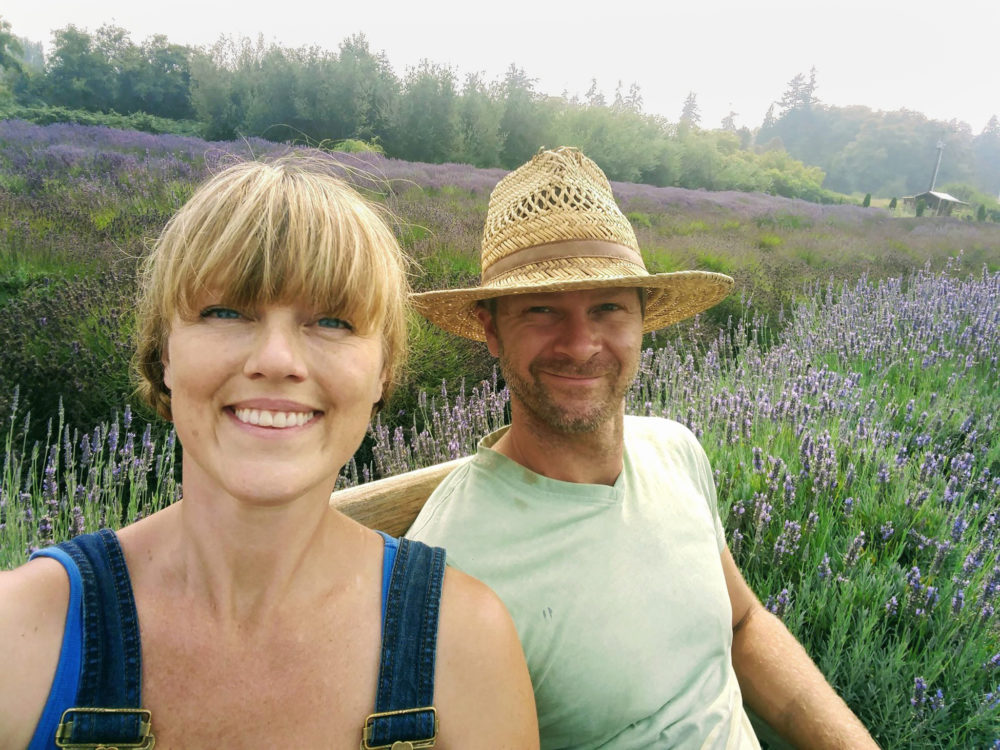Heritage Barn Grants: Lotzgesell Barn

Preserving history and agriculture in the Sequim-Dungeness Valley
By Rebecca Olson
The Washington State Heritage Barn Initiative has helped saved 122 barns throughout the state since its inception in 2007, not only preserving local history and culture but helping small farms restore to full use what is arguably their most valuable and important farm structure: the barn. The Lavender Connection farm in Sequim, a grant recipient from the 2017-2019 biennium, is a perfect example of a working farm being placed on more secure financial footing and en route to a brighter future in no small thanks to the success of this program.
The Lavender Connection farm is a working lavender farm that is open to the public during the summer season when lavender is in bloom. The farm produces all things lavender: fresh cut lavender, distilled lavender essential oil, dried lavender bundles, lavender bud, and over 30 different bath, body, and home products all made from lavender grown on the site. The farm also provides a perfect venue for lavender agritourism, which Sequim has become known for.
Their barn is used for three primary purposes: storage for farm equipment, space to hang and store dried lavender and defoliated bud, and a small retail store in the southwest corner where the milking stations used to be. The barn is important to customer experience at the farm; customers especially love to visit the store in the barn because it gives them a very up close view of its historic interior and architectural eccentricities. The barn is also a significant component of Lavender Connection’s branding and business identity, as it is one of the primary features that makes their farm unique from other lavender farms in the area.
The Sequim-Dungeness Valley has a long, rich agricultural history and became one of the state’s major dairy regions in the first half of the 1900s. Dairy barns defined the character of this region for decades, but unfortunately, barn fires, severe storms, encroaching development, and the inevitable effects of time have destroyed the majority of these historic barns. The Lavender Connection dairy barn, built circa 1913, is one of the oldest barns still standing in the former New Dungeness area of Sequim. Its shape is a combination of a saltbox roofline with an attached lean-to on the south side.
The barn is an incredibly important piece of the Lotzgesell property; George Henry Lotzgesell was one of the first pioneers to homestead in the Dungeness Valley when he settled here in 1859. After clearing the land of timber, the Lotzgesell family eventually began dairy and cattle farming. In addition to farming, George Henry Lotzgesell was a prominent member of the Dungeness and Sequim communities, as were his sons, George Jr. and Frank, who each inherited a portion of the homestead after his death. In 1913, both sons built dairy barns within a few miles of each other and became successful dairy farmers in their own rights. Several farmers have owned the Lotzgesell properties over the years, and it eventually was subdivided into smaller parcels, separating the historic barn from the original farmhouse, which is currently owned by a neighbor to the north. The current Lavender Connection parcel, including the barn built by Frank, was sold to Richard and Susan Olson in 2004. “Our parcel is just a small portion of the original Lotzgesell homestead, but fortunately the land has escaped extensive development and has been farmed almost continuously since it was originally settled by the Lotzgesells in 1864,” their daughter Rebecca explained. George Lotzgesell Jr.’s dairy barn is also still standing off Lotzgesell Road, operating continuously as a dairy farm up to the 1990s.
Over the years, the Olsons have done their best to maintain and restore the barn and had intended to make additional repairs incrementally over the next decade as finances allowed. Unfortunately, severe windstorms took their toll over the years, completely destroying one of the cupolas and damaging the barn to the point where it became critical that they make repairs as soon as possible. A serendipitous visit from a neighbor (Judy Stipe, executive director of Sequim Museum and Arts) who suggested they apply for the Heritage Barn Grant program she’d just heard about, put them on the path of applying and ultimately being accepted as a grantee. The Olsons were thrilled and relieved that the formerly daunting prospect of how to save the barn, and whether to spend limited farm funds, was now resolved.
The first hiccup in the project came when none of the contractors who’d bid on the different project components never returned their calls. Fortunately, barn owner Rick, a retired professional engineer, took on project management, and daughter Rebecca’s husband, Doug Mazzeo, a professional carpenter and builder, became the new contractor. Rebecca and Doug had initially moved out to Sequim from Seattle temporarily to spend the summer of 2018 helping out her parents with the summer tourist season, but with the barn project in need, they found a renter for their Seattle home and settled in for the duration of the project.
The first critical step was to prevent the barn from structural collapse by restoring and repairing four support columns along with retrofitting or replacing barn rafters and beams where necessary. “There were five more rafters than we thought we’d have to replace,” Mazzeo explained. In all locations where rotten beams were found, the beams were replaced with new rough-cut timbers to match the original double layer beams used throughout the barn. In addition, after the project began, it was determined that the levels to which a previous contractor had raised a different row of support columns were not sufficient to bring that section of roof into alignment, so that additional work was added to the “to-do” list.
The second major component of the project was replacing the roof of the barn, which had deteriorated rapidly after recent windstorms, forming large holes including one over the corner of the barn where the retail store is located. While the Olsons originally intended to install a metal roof, once Rick and Doug took measurements and consulted with a family member who is a professional roofer, they determined that a metal roof wouldn’t allow for the inches of variation in height that would exist even after the barn was stabilized, so they settled on cedar shakes. Mazzeo said the toughest part of the project was adding the cedar shakes on the barn’s east side roof—standing atop rotting wood about 20 feet up. The final phase of the project was rebuilding the cupola that had been destroyed to match the original existing cupola and reinforcing and repairing the other remaining cupola.
The Heritage Barn Grant allowed the Olsons to complete all of the work in fewer than 12 months. Dubbed “Big Red,” the Olsons’ forklift became a somewhat unexpected key piece in the renovation. In addition to being an essential piece of equipment for the column work, they attached 16-foot posts to “Big Red” to help temporarily support a sagging portion of the roof while Doug began selective demo. “Big Red” (and the recently completed structural work) helped the barn survive the brunt of an unprecedented two-foot snowfall in Sequim that occurred over the winter during the project; other local Sequim barns were not as lucky.
Though Rebecca and Doug were planning to return to Seattle before the barn renovation project, their time living at the farm and managing the barn project shifted their perspective on how to spend the next period of their adult lives. They’re now hoping to find a way to stay in Sequim at least part of the year, taking over the Lavender Connection farm (with the continued assistance of the other Olson children) when Rick and Susan finally retire for good.
Now that the barn has been made structurally sound and weather-proof, the family hopes to continue restoring additional elements, such as updating the electrical panel and replacing missing and damaged siding. The barn now has the potential to increase the space they use to hang their lavender, expand the store, add a woodworking shop in the corner, and even open up portions of the interior to allow customers to tour. In addition, a fully restored barn significantly increases their business potential to include an event space, should they choose to incorporate events into their business model at a future date.
The Frank Lotzgesell Barn is a testament to the hardworking people of the Sequim-Dungeness Valley and the dairy farms that put that region on the map. Now an integral part of the Olsons’ working lavender farm, it is a bridge between old and new Sequim: a symbol of the preservation of rural farmland through lavender farming and agritourism.
The Heritage Barn Initiative is a program of the Department of Archaeology & Historic Preservation (DAHP) and is managed by the Washington Trust for Historic Preservation. For more information, please visit dahp.wa.gov/heritagebarngrants.
Photo at top of page: The Lotzgesell Barn with a straightened and freshly shingled roof.

View of the Lotzgesell Barn at the Lavender Connection farm before the grant project, showing significant roof deterioration and structural sagging.
 Rebecca Olson and Doug Mazzeo moved out to Sequim to help restore the barn at Lavender Connection.
Rebecca Olson and Doug Mazzeo moved out to Sequim to help restore the barn at Lavender Connection.